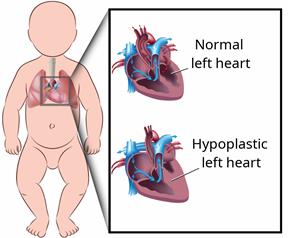When You're Born With a Heart Not Fully Developed on the Left Side (Hypoplastic Left Heart Syndrome): What to Know

Hypoplastic left heart syndrome happens when the left side of the heart isn't fully developed. This problem is present at birth (congenital).
In a normal heart:- Blood from the right side of the heart is pumped to the lungs.
- The oxygen-rich blood goes to the left side of the heart, which is then pumped back out to the body.
In hypoplastic left heart syndrome, structures on the left side of the heart are small or missing. This makes it hard for the heart to pump enough blood out to the body.
Surgery is needed to treat this problem. After surgery, follow-up care and surgery may be needed throughout the child's life.
What are the causes?
The cause of hypoplastic left heart syndrome is usually not known. Possible causes may be:- Changes in genes when a baby is growing before birth.
- Things that affect the mother, such as medicines, diet, or things in the environment.
What increases the risk?
Hypoplastic left heart syndrome is more likely to happen in:- Males.
- A child who has a sibling with hypoplastic left heart syndrome.
What are the signs or symptoms?
Symptoms usually develop within a few hours or days after birth. They may include:- Trouble breathing.
- Fast breathing.
- Weak or fast heartbeat.
- Pale or blue skin, or cold hands and feet.
- Poor feeding.
- Lack of strength and energy.
How is this diagnosed?
This problem may be found before birth during an imaging test called a fetal ultrasound.
After birth, it may be diagnosed based on:- Your child's symptoms.
- A physical exam. The health care provider may hear an abnormal heart sound (murmur) when listening to your child's heart.
- An echocardiogram. This test uses sound waves to make images of your child's heart and blood vessels.
- Newborn pulse oximetry. This checks the amount of oxygen in the blood.
How is this treated?
The provider may do a series of three surgeries that improve blood flow from the right side of your child's heart to the body. These include:- A Norwood procedure in the first 2 weeks after birth.
- This surgery makes it easier for the right side of the heart to pump blood to both the lungs and the body.
- A bidirectional Glenn shunt or hemi-Fontan procedure when the child is 2–6 months old.
- After this surgery, blood that returns from the upper body will be able to go straight to the lungs. This reduces the work of the right side of the heart.
- A Fontan procedure when the child is around 3 years old.
- After this surgery, blood that returns from the lower body will be able to go directly to the lungs.
Most children improve after these surgeries. Some children may need a heart transplant.
Follow these instructions at home:
-
Learn as much as you can about your child's heart problem.
- Your child may need extra care for feeding and nutrition. For example, your child may need to have a feeding tube for a while, or you may need to feed your child with a higher-calorie formula.
- Work with your child's nutrition specialist to make sure they're getting enough nutrients.
-
Give your child medicines only as told.
-
Have your child exercise as told.
-
Keep all follow-up visits. Your child will need lifelong care from a heart specialist.
Where to find more information
To learn more, go to these websites:Contact a health care provider if:
-
Your child isn't feeding well or gaining weight.
-
Your child is breathing faster than usual.
-
Your child has poor strength and energy.
- Your baby is younger than 3 months old and has a temperature of 100.4°F (38°C) or higher.
- Your child is 3 months old or older and has a temperature of 102.2°F (39°C) or higher.
- Your child has a fever, and they look or act sick in a way that worries you.
If you can't reach the provider, go to an urgent care or emergency room.
Get help right away if:
-
Your child has trouble breathing.
-
Your child's skin turns pale or blue.
These symptoms may be an emergency. Do not wait to see if the symptoms will go away. Call 911 right away.
This information is not intended to replace advice given to you by your health care provider. Make sure you discuss any questions you have with your health care provider.

